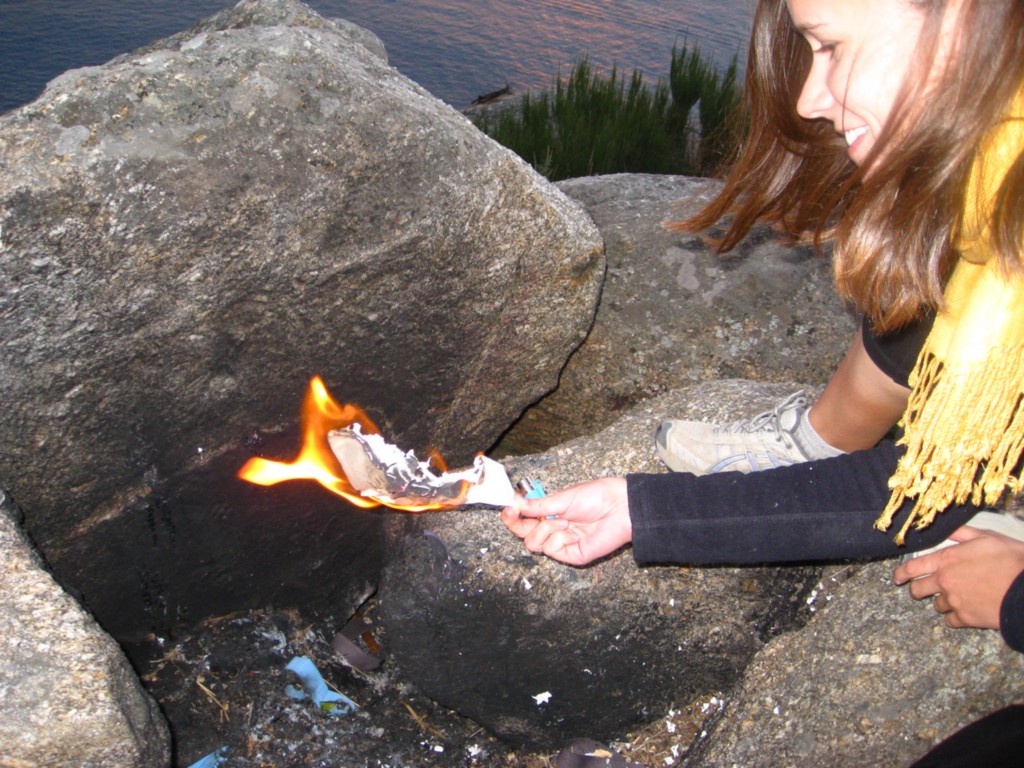Burn It All Down

I don’t have any regrets from before November of 2007, because I set them all on fire at the end of the world.
When I was twenty-two, I walked the Way of Saint James, a five-hundred-mile pilgrimage through northwestern Spain. I had graduated from college, finished a summer job, and had vague plans to move to New York to work in magazines. My walking companion Victoria and I took thirty-four days to reach Santiago de Compostela, the capital of Galicia, where according to medieval legend, a bright star marked the burial site of the remains of the apostle James.
The Camino is full of traditions, and we observed as many of them as we could. We got our pilgrims’ passports stamped in each place we stayed, tied scallop shells to our backpacks, and drank wine from a fountain at Bodegas Irache at ten in the morning. We also made our own traditions — selfies before they were called that, which we called “long-arm shots,” and reporting in to friends and family in a weekly email. Most pilgrim rituals are concentrated upon arrival in Santiago, before and after Mass at the Romanesque cathedral. Some rituals we performed only symbolically — much of the stonework in the Portico of Glory is now eroded from centuries of wear. We stretched our hands in the direction of the tree of Jesse instead of fitting our fingers in its grooves, and we bowed toward a statue of Master Mateo instead of knocking our foreheads against it. Six priests hoisted up a giant incense burner, called a botafumeiro, to waft it up and down the aisle, the better to cover the stench of dirty pilgrims. Victoria took a Communion wafer while I waited in the pews, because she had been baptized and I had not. We stood in a long, slow-moving line that wound around behind the altar, where we each hugged the enormous metal-and-gold statue of Saint James.
But my favorite tradition from the Camino was the coda. Four days’ walk (or an hour-and-a-half bus ride, if you have a flight to catch) beyond Santiago is Cape Finisterre, the westernmost point in Spain. The Romans believed this rocky crag was the edge of the world — finis terrae is Latin for “the end of the land.” In very modern history, it became customary for pilgrims to burn some items of clothing, especially their boots, that they wore on their long journey. Part molting, part effigy, it’s an unburdening of a former self, who used to carry a heavy load. Leave it all behind, and return home with only your memories! Victoria and I didn’t have a second pair of shoes, not counting shower flip flops, and we had no layers of clothing to spare. (We’d chosen to walk the Camino in the fall rather than the high season of summer; halfway through the trip, I had to buy a wool sweater.) Instead, we brought pen and paper and a Bic lighter, and wrote out a list of our regrets as we watched the sun set over a believably endless horizon.
To this day, I can’t remember what was on that list besides some kind of vague, reaching statements about my first love, about whom I had recurring dreams for the first and only time in my life. Victoria took a picture of me, gazing into the flame, smiling — I look happy and relaxed. I don’t think I really knew what a regret was then. And ever since, I’ve tried not to learn.
Save Yourself is the Awl’s farewell to 2015.
